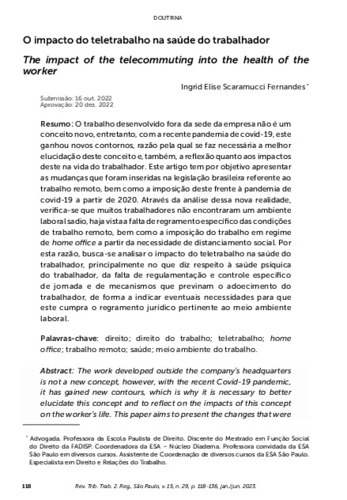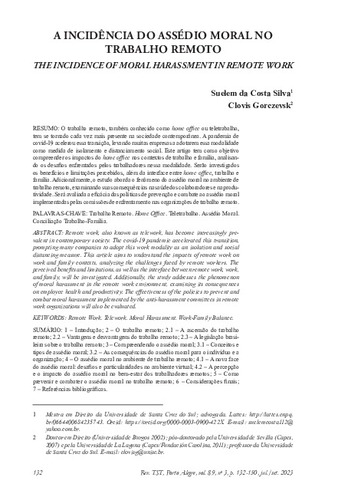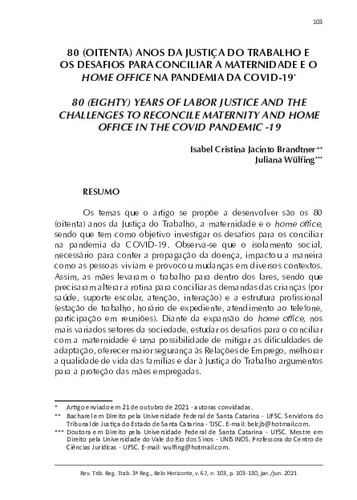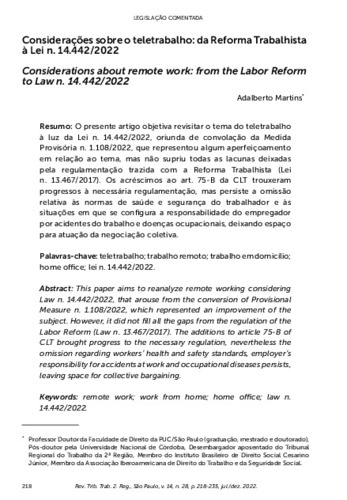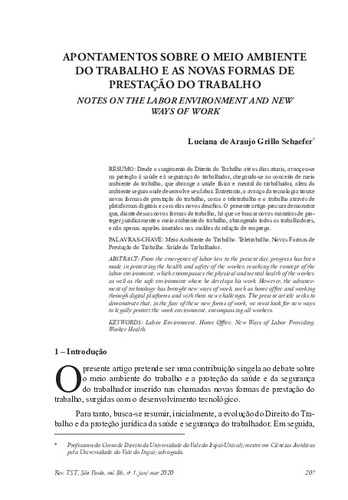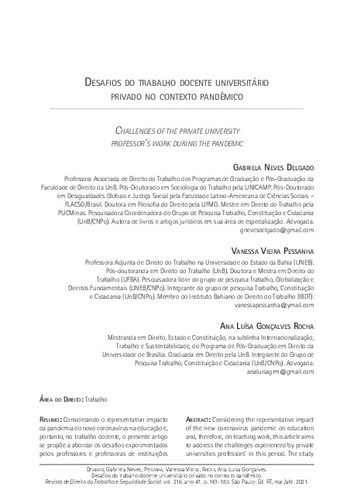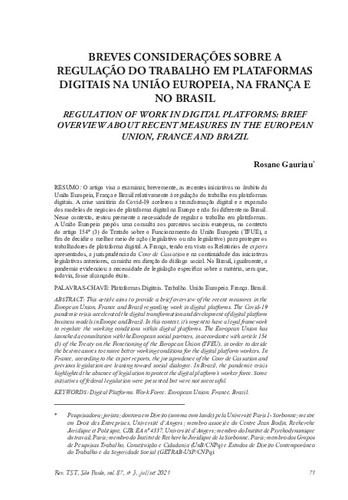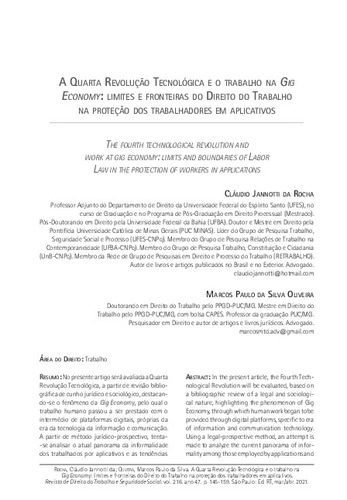Mostrar el registro sencillo del ítem
Artigo de periódico
Tecnologias e o teletrabalho pós-pandemia: o controle invisível aos olhos do subordinado
| dc.contributor.author | Calcini, Ricardo Souza | |
| dc.contributor.author | Camara, Amanda Paoleli | |
| dc.date.accessioned | 2024-06-25T16:26:25Z | |
| dc.date.available | 2024-06-25T16:26:25Z | |
| dc.date.issued | 2022-12 | |
| dc.identifier.citation | CALCINI, Ricardo; CAMARA, Amanda Paoleli. Tecnologias e o teletrabalho pós-pandemia: o controle invisível aos olhos do subordinado = Technologies and post-pandemic remote work: invisible control to the eyes of the subordinate. Revista da Escola Judicial do TRT4, Porto Alegre, v. 4, n. 7/8, p. 391-419, jan./dez. 2022. | pt_BR |
| dc.identifier.uri | https://hdl.handle.net/20.500.12178/234640 | |
| dc.description.abstract | [por] Com o avanço da tecnologia e a Revolução Industrial 4.0, o teletrabalho passou do imaginário coletivo para uma perspectiva atual e realista, sobretudo com a sua regulamentação pela Lei nº 13.467 (BRASIL, 2017). A pandemia de covid-19 acelerou essa tendência, surgindo o trabalho remoto como necessário para a manutenção das atividades empresariais e a sobrevivência da economia à época. O modelo conhecido como home office foi inicialmente um desafio, pois precisou superar barreiras do conservadorismo empresarial e a desigualdade social. Já adaptados, os profissionais no Brasil, em sua maioria, preferem a manutenção do regime integral ou um modelo híbrido de trabalho, ambos adotados por diversas empresas com a retomada da economia pós-pandemia, resultando na MP nº 1.108 (BRASIL, 2022), posteriormente convertida na Lei nº 14.442 (BRASIL, 2022). A pesquisa visa compreender a dinâmica entre essa tendência de trabalho e o uso da tecnologia na sua implementação, observando suas implicações no controle de jornada e de produção pela subordinação digital. O estudo é qualitativo, utilizando-se do método dedutivo, com base em pesquisa bibliográfica, artigos científicos e periódicos, matérias jornalísticas, legislação e jurisprudência sobre o assunto. Conclui-se, por conseguinte, que a tecnologia que possibilita inúmeros modos de trabalho e que enseja maior sensação de liberdade e qualidade de vida aos trabalhadores possa também ser abusiva, sem descurar que a prova digital é uma aliada ao princípio da verdade real e da segurança jurídica. | pt_BR |
| dc.description.abstract | [eng] With the advancement of technology and the fourth industrial revolution, telework has moved from the collective imagination to a current and realistic perspective, especially with its regulation by Law No. 13,467 (BRASIL, 2017). The COVID-19 pandemic accelerated this trend, with remote work emerging as necessary for the maintenance of business activities and the survival of the economy at the time. The model known as home office was initially a challenge, as it needed to overcome barriers of business conservatism and social inequality. Now adapted, most professionals in Brazil, prefer the maintenance of the full-time regime or a hybrid work model, both adopted by several companies with the post-pandemic economic recovery, resulting in the MP 1,108 (BRASIL, 2022b), later converted into Law No. 14,442 (BRASIL, 2022a). This research aims to understand the dynamics between this work trend and the use of technology in its implementation, observing its implications in the control of working hours and production by digital subordination. The study is qualitative, using the deductive method, based on bibliographic research, scientific articles and periodicals, newspaper articles, legislation and case law on the subject. We conclude, therefore, that the technology that makes countless ways of working possible and that gives workers a greater sense of freedom and quality of life, can also be abusive; not to mention that digital proof is an ally to the Principle of Actual Truth and legal security. | pt_BR |
| dc.description.tableofcontents | Panorama geral sobre o teletrabalho e suas espécies no pós-pandemia -- Onipresença do empregador: o controle digital pelas novas formas de tecnologia: Abuso do direito e a precarização do trabalho -- Aspectos gerais das provas digitais | pt_BR |
| dc.language.iso | pt_BR | pt_BR |
| dc.relation.ispartof | Revista da Escola Judicial do TRT4: vol. 4, n. 7/8 (jan./dez. 2022) | pt_BR |
| dc.subject | Teletrabalho, Brasil | pt_BR |
| dc.subject | Jornada de trabalho, controle, Brasil | pt_BR |
| dc.subject | Produtividade, controle, Brasil | pt_BR |
| dc.subject | Direito à privacidade, Brasil | pt_BR |
| dc.subject | Prova (direito), inovação tecnológica, Brasil | pt_BR |
| dc.title | Tecnologias e o teletrabalho pós-pandemia: o controle invisível aos olhos do subordinado | pt_BR |
| dc.title.alternative | Technologies and post-pandemic remote work: invisible control to the eyes of the subordinate | pt_BR |
| dc.type.genre | Artigo de periódico | pt_BR |
| dc.identifier.rvbisys | 001262569 | |
| dc.relation.ispartoflink | https://hdl.handle.net/20.500.12178/228536 | pt_BR |
Este ítem aparece en la(s) siguiente(s) colección(ones)
-
Artigos9566



